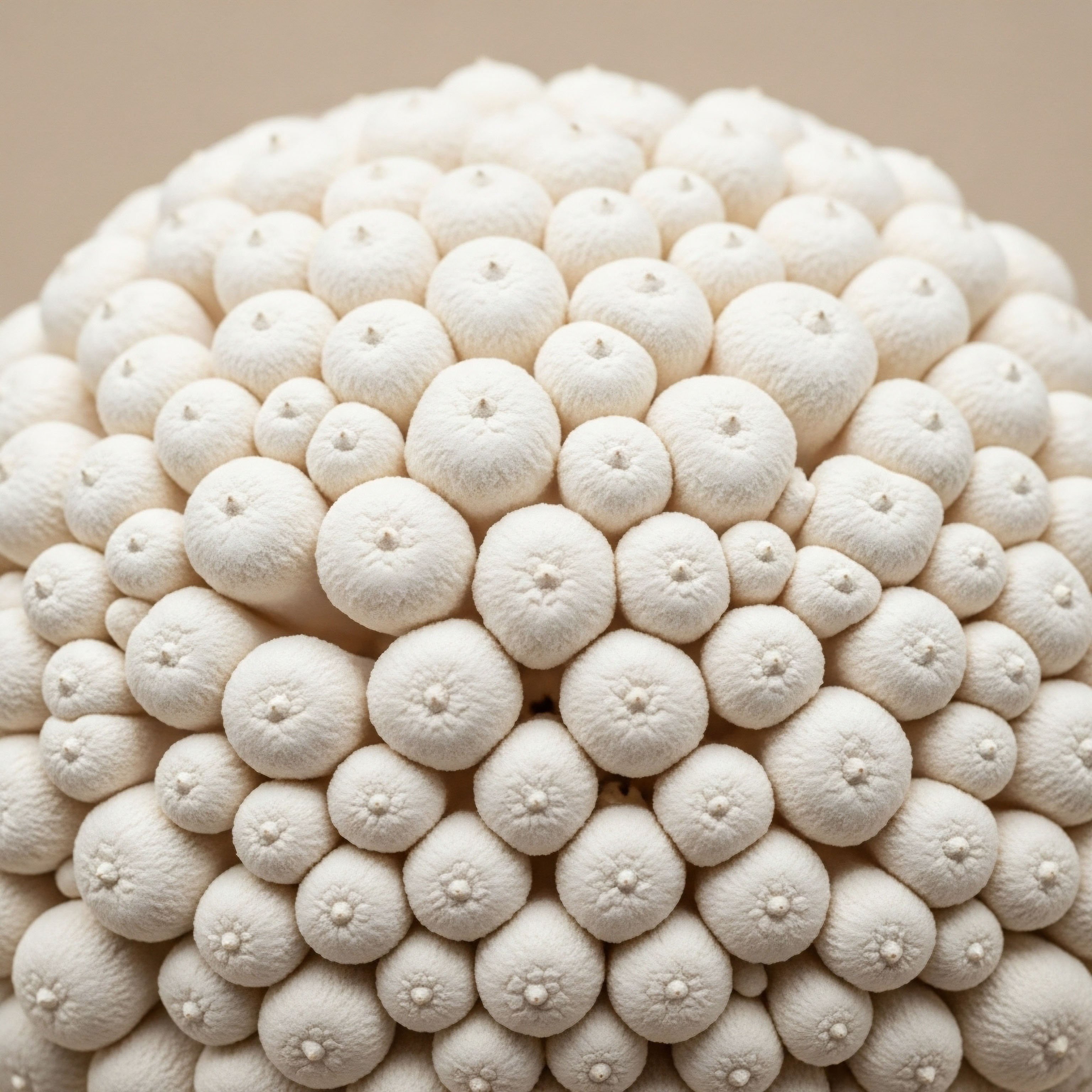

Fundamentals
That persistent fatigue, the frustrating dip in desire, the sense that your body’s vitality is slipping away ∞ these are not isolated feelings. They are signals from a deeply interconnected system within you, a biological conversation that has been disrupted.
Many people experience these shifts and attribute them to age or stress alone, yet frequently the root cause is a metabolic disturbance that ripples through the entire endocrine network. The conversation begins with a single, powerful hormone ∞ insulin.
Its primary role is to manage blood sugar, acting as a key that unlocks your cells to allow glucose to enter and provide energy. When this system works efficiently, your body is considered insulin-sensitive. Your cells respond readily to insulin’s signal, maintaining stable energy levels and supporting the function of every other system, including your hormonal architecture.
However, a modern lifestyle characterized by processed foods, chronic stress, and sedentary habits can overwhelm this delicate process. When cells are constantly bombarded with glucose, they begin to down-regulate their response to insulin. They become resistant.
This state, known as insulin resistance, forces the pancreas to produce even more insulin to get the job done, leading to chronically high levels of insulin in the bloodstream, a condition called hyperinsulinemia. This is where the connection to hormonal balance and libido becomes profoundly clear.
The endocrine system is not a collection of independent glands; it is a finely tuned orchestra. Insulin is a powerful conductor, and when it is playing too loudly, it drowns out the other instruments. The sex hormones ∞ testosterone, estrogen, and progesterone ∞ are particularly susceptible to this disruption. Their production, transport, and signaling are all thrown off-key by the metabolic chaos of insulin resistance.
The journey to understanding hormonal imbalance often begins with recognizing that metabolic health and endocrine function are two sides of the same coin.

The Metabolic Foundation of Hormonal Health
To grasp the connection, it is helpful to visualize your body’s hormonal command center, the Hypothalamic-Pituitary-Gonadal (HPG) axis. This is the communication pathway that governs sexual function and reproduction. The hypothalamus in the brain releases Gonadotropin-Releasing Hormone (GnRH), which signals the pituitary gland to release Luteinizing Hormone (LH) and Follicle-Stimulating Hormone (FSH).
These hormones, in turn, travel to the gonads (testes in men, ovaries in women) and stimulate the production of testosterone and estrogen. Insulin resistance directly interferes with this elegant communication system. High insulin levels can disrupt the pulsatile release of GnRH from the hypothalamus, effectively scrambling the initial command.
This creates a downstream effect, reducing the pituitary’s output of LH and FSH and, consequently, lowering the production of sex hormones in the gonads. The result is a state of functional hypogonadism, where the reproductive system is underperforming not because of a primary issue with the testes or ovaries, but because of a metabolic problem upstream.

How Insulin Resistance Directly Lowers Testosterone in Men
For men, the impact of insulin resistance on testosterone is particularly direct and well-documented. The Leydig cells in the testes, which are responsible for producing the vast majority of a man’s testosterone, are directly affected by high insulin levels. Studies show that increasing insulin resistance is associated with a decrease in Leydig cell testosterone secretion.
This means the very factories that produce the primary male androgen are being suppressed. Furthermore, insulin resistance contributes to another significant issue ∞ the reduction of Sex Hormone-Binding Globulin (SHBG). SHBG is a protein produced by the liver that binds to sex hormones in the bloodstream, regulating their availability to tissues.
When SHBG levels are healthy, a balanced amount of testosterone is kept in reserve, while a smaller, “free” portion is available to act on cells. High insulin levels directly suppress the liver’s production of SHBG. With less SHBG available, a higher percentage of testosterone becomes “free.” While this might initially sound beneficial, it creates a feedback loop that ultimately lowers total testosterone.
The body senses the higher level of free hormone and signals the HPG axis to reduce overall production. Additionally, the excess free testosterone is more readily converted to estrogen by the enzyme aromatase, particularly in adipose (fat) tissue, which is often increased in states of insulin resistance. This combination of suppressed production and increased conversion creates a hormonal environment that undermines masculine vitality, leading to symptoms like low libido, erectile dysfunction, fatigue, and loss of muscle mass.

The Complex Picture in Women
In women, the relationship between insulin resistance and hormonal balance is more complex, but equally disruptive. High insulin levels stimulate the ovaries to produce an excess of androgens, primarily testosterone. This is a hallmark of Polycystic Ovary Syndrome (PCOS), one of the most common endocrine disorders in women of reproductive age.
This overproduction of androgens can disrupt or halt ovulation, leading to irregular cycles, infertility, and symptoms like acne and hirsutism (unwanted hair growth). Simultaneously, just as in men, high insulin suppresses SHBG production in the liver. This means that even more of the already elevated testosterone is in its free, biologically active form, exacerbating the androgen-dominant symptoms.
The balance between estrogen and progesterone is also thrown into disarray. Without regular ovulation, the corpus luteum does not form, and progesterone production plummets. This creates a state of estrogen dominance relative to progesterone, which can contribute to heavy or irregular bleeding, mood swings, and an increased risk for certain health conditions.
For post-menopausal women, insulin resistance can worsen symptoms like hot flashes and further diminish libido, which is already affected by the natural decline in both estrogen and testosterone.
Insulin resistance acts as a system-wide disruptor, altering not just how hormones are made, but how they are transported and received by the body’s cells.

Libido the Canary in the Coal Mine
Libido, or sexual desire, is a complex interplay of biology, psychology, and relationship dynamics. From a biological standpoint, it is profoundly sensitive to the hormonal and metabolic environment. It often serves as an early warning sign that something is amiss within the endocrine system.
When insulin resistance begins to disrupt the HPG axis and alter the balance of sex hormones, a decline in libido is one of the first and most common symptoms for both men and women. This is because desire is not just about having enough testosterone or estrogen; it is about the delicate balance and proper functioning of the entire system.
The fatigue that accompanies poor metabolic health, the mood changes driven by hormonal fluctuations, and the direct impact of insulin on neurotransmitters like dopamine all contribute to a diminished interest in sexual activity. Addressing the root cause ∞ the underlying insulin resistance ∞ is therefore the foundational step in restoring not only libido but overall hormonal harmony and vitality.
It requires a shift in perspective, viewing the body as an integrated system where metabolic health is the bedrock upon which hormonal well-being is built.


Intermediate
Understanding that insulin resistance disrupts hormonal balance is the first step. The next is to explore the precise biological mechanisms through which this disruption occurs and to understand the clinical protocols designed to intervene. This requires a deeper look at the cellular and systemic conversations that go awry and how targeted therapies can help recalibrate the system.
The connection is not a simple one-to-one relationship; it is a cascade of interconnected events that begins with cellular energy metabolism and ends with the subjective experience of vitality and desire. At the heart of this cascade is the way insulin resistance fundamentally alters the body’s communication networks, from the central command of the HPG axis to the local environment of hormone-producing tissues.

The HPG Axis under Metabolic Stress
The Hypothalamic-Pituitary-Gonadal (HPG) axis functions like a sophisticated thermostat system, constantly monitoring and adjusting sex hormone levels. Insulin resistance throws a wrench into this regulatory machinery. The hypothalamus, which initiates the entire hormonal cascade by releasing GnRH in precise pulses, has insulin receptors.
In a state of insulin sensitivity, insulin helps modulate GnRH release, contributing to a healthy reproductive function. However, in a state of chronic hyperinsulinemia and insulin resistance, this signaling becomes dysfunctional. The brain can become resistant to insulin’s effects, much like peripheral tissues.
This can lead to a blunted or erratic GnRH pulse, which in turn disrupts the pituitary’s release of LH and FSH. The result is a confused signal being sent to the gonads. In men, this typically manifests as secondary hypogonadism, where the testes are capable of producing testosterone but are not receiving the proper stimulation to do so.
In women, particularly those with PCOS, the disruption can lead to an elevated LH-to-FSH ratio, which promotes androgen excess from the ovaries.

SHBG the Critical Regulator
Sex Hormone-Binding Globulin (SHBG) is a key player in this story, acting as the primary transport protein for testosterone and estradiol in the blood. Its production in the liver is exquisitely sensitive to insulin. High insulin levels act as a potent suppressor of the SHBG gene. When insulin resistance sets in and hyperinsulinemia becomes chronic, SHBG production plummets. This has profound consequences for hormonal balance.
- For Men ∞ Low SHBG means a lower total testosterone level is required to maintain the same level of free, active testosterone. The body’s feedback loop interprets this as a signal to downregulate testosterone production via the HPG axis. This creates a vicious cycle ∞ insulin resistance lowers SHBG, which in turn contributes to lower total testosterone production.
- For Women ∞ In the context of PCOS, where insulin resistance drives ovarian androgen overproduction, low SHBG is a double blow. It increases the proportion of already-high testosterone that is in its free, bioactive form, intensifying symptoms like acne, hirsutism, and hair loss.
The clinical implication is that measuring only total testosterone can be misleading. A person might have a “low-normal” total testosterone but suffer from symptoms of deficiency because their SHBG is also low, leading to a less-than-optimal free testosterone level.
Conversely, someone with high SHBG might have a “normal” total testosterone but have low free testosterone and experience symptoms. A comprehensive lab panel must include Total and Free Testosterone, as well as SHBG, to get a clear picture of the hormonal landscape.

Clinical Protocols for Restoring Balance
When lifestyle interventions like diet, exercise, and stress management are insufficient to correct the hormonal imbalances caused by long-standing insulin resistance, targeted clinical protocols can be employed. These protocols are not about simply replacing a missing hormone; they are about restoring the proper function and communication within the endocrine system.

Testosterone Replacement Therapy TRT
For men with clinically diagnosed hypogonadism, where insulin resistance has suppressed the HPG axis and testicular function, TRT is a cornerstone of treatment. The goal is to restore testosterone levels to an optimal physiological range, which not only addresses symptoms like low libido and fatigue but can also improve insulin sensitivity, creating a positive feedback loop.
| Component | Purpose | Typical Administration |
|---|---|---|
| Testosterone Cypionate | The primary androgen replacement. It restores physiological testosterone levels, improving muscle mass, bone density, mood, and libido. It also has a beneficial effect on insulin sensitivity. | Weekly intramuscular or subcutaneous injections (e.g. 100-200mg/week). |
| Gonadorelin | A GnRH analogue. It mimics the natural signal from the hypothalamus to the pituitary, stimulating the release of LH and FSH. This helps maintain testicular size and endogenous testosterone production. | Subcutaneous injections, typically twice a week. |
| Anastrozole | An aromatase inhibitor. It blocks the conversion of testosterone to estrogen. This is used to manage estrogen levels and prevent side effects like gynecomastia and water retention, especially in men with higher body fat. | Oral tablet, often taken twice a week, with dosage adjusted based on estradiol lab results. |
| Enclomiphene | A selective estrogen receptor modulator (SERM). It can be used to block estrogen’s negative feedback at the pituitary, thereby increasing LH and FSH production and stimulating the body’s own testosterone synthesis. | Oral tablet, used as an alternative or adjunct to TRT. |
For women, particularly in the peri- and post-menopausal stages, low-dose testosterone therapy can be highly effective for addressing low libido, fatigue, and cognitive fog. The protocols are carefully dosed to avoid masculinizing side effects.
- Testosterone Cypionate ∞ Small weekly subcutaneous injections (e.g. 10-20 units) can restore youthful testosterone levels, significantly improving sexual desire and overall vitality.
- Progesterone ∞ Often prescribed alongside testosterone, especially for women who still have a uterus, to balance the effects of estrogen and support mood and sleep.
- Pellet Therapy ∞ Long-acting testosterone pellets implanted under the skin can provide a steady state of the hormone for several months, often combined with anastrozole if needed to control estrogen conversion.
Effective hormonal therapy is a dynamic process of restoring physiological balance, not just achieving a specific number on a lab report.

Growth Hormone Peptide Therapy
Insulin resistance and hormonal decline are also linked to a decrease in the pulsatile release of Growth Hormone (GH) from the pituitary. GH plays a critical role in body composition, cellular repair, and overall metabolic health. Peptide therapies are designed to stimulate the body’s own production of GH in a more natural, pulsatile manner than direct GH injections.
| Peptide | Mechanism of Action | Primary Benefits |
|---|---|---|
| Sermorelin | A Growth Hormone-Releasing Hormone (GHRH) analogue. It directly stimulates the pituitary to produce and release GH. | Improved sleep quality, increased lean body mass, reduced body fat, enhanced recovery. |
| Ipamorelin / CJC-1295 | A combination of a GHRH analogue (CJC-1295) and a Ghrelin mimetic (Ipamorelin). This dual action provides a strong, clean pulse of GH release with minimal side effects. | Potent fat loss and muscle gain, improved skin elasticity, enhanced sleep and recovery, without significantly impacting cortisol or prolactin. |
| Tesamorelin | A potent GHRH analogue specifically studied for its ability to reduce visceral adipose tissue (VAT), the metabolically dangerous fat surrounding the organs. | Targeted reduction of visceral fat, improved lipid profiles, and enhanced cognitive function in some populations. |
These peptide protocols can be particularly beneficial for individuals with insulin resistance, as improving GH levels can lead to better body composition (more muscle, less fat), which in itself is a powerful driver of improved insulin sensitivity. By addressing both the sex hormone and growth hormone axes, a comprehensive clinical approach can effectively reverse the metabolic and hormonal decline, restoring the body’s internal communication systems and revitalizing overall health and libido.


Academic
The bidirectional relationship between insulin resistance and hypogonadism represents a critical nexus in modern metabolic medicine. While the clinical associations are well-established, a deeper, academic exploration reveals a complex molecular dialogue between metabolic and reproductive signaling pathways. This dialogue is disrupted at multiple levels, from gene transcription in hepatocytes to enzymatic activity within steroidogenic cells.
To fully appreciate the role of insulin sensitivity in hormonal balance, we must move beyond systemic descriptions and examine the intricate cellular and molecular mechanisms that underpin this pathophysiology. The focus here will be on the direct and indirect effects of hyperinsulinemia on the key cellular players in sex hormone regulation ∞ the hepatic production of SHBG and the gonadal synthesis of steroid hormones.

Molecular Regulation of SHBG and the Impact of Hyperinsulinemia
The suppression of Sex Hormone-Binding Globulin (SHBG) by insulin is a central mechanism linking metabolic dysfunction to sex hormone dysregulation. The gene for SHBG is located on chromosome 17 and its expression in hepatocytes is primarily regulated by a complex interplay of transcription factors.
The most critical of these is Hepatocyte Nuclear Factor 4-alpha (HNF-4α). HNF-4α acts as a primary positive regulator of the SHBG promoter, driving its transcription. Insulin exerts its suppressive effect on SHBG production not by directly acting on the SHBG gene itself, but by initiating a signaling cascade that ultimately downregulates HNF-4α.
Chronic hyperinsulinemia, the hallmark of insulin resistance, leads to increased signaling through the phosphatidylinositol 3-kinase (PI3K)/Akt pathway in hepatocytes. This pathway, while essential for metabolic regulation, also leads to the activation of sterol regulatory element-binding protein-1c (SREBP-1c), a key lipogenic transcription factor.
Increased SREBP-1c activity promotes de novo lipogenesis, leading to hepatic steatosis (fatty liver), a condition tightly linked to insulin resistance. Crucially, this lipogenic environment and the associated inflammatory cytokines, such as TNF-α and IL-6, create a cellular milieu that suppresses HNF-4α expression and activity.
Therefore, insulin’s effect on SHBG is indirect but potent ∞ it fosters a metabolic state in the liver that is inhospitable to the transcription of the SHBG gene. This molecular link explains the strong inverse correlation observed in clinical studies between markers of insulin resistance (like HOMA-IR) and circulating SHBG levels.

What Are the Implications of Suppressed SHBG for Hormone Bioavailability?
The reduction in circulating SHBG has profound implications for the bioavailability and metabolism of sex steroids. With less SHBG to bind testosterone and estradiol, the free fraction of these hormones increases. In men, this leads to two critical downstream events.
First, the elevated free testosterone provides a stronger negative feedback signal to the hypothalamus and pituitary, suppressing GnRH and LH secretion and thereby reducing de novo testosterone synthesis in the Leydig cells. Second, the increased availability of free testosterone as a substrate for the aromatase enzyme, which is highly expressed in visceral adipose tissue, accelerates its conversion to estradiol.
This results in a hormonal profile common in metabolic syndrome ∞ low total testosterone, inappropriately normal or low-normal free testosterone, and elevated estradiol. This hormonal signature is itself metabolically unfavorable, as elevated estradiol in men can further suppress the HPG axis and contribute to adiposity. This creates a self-perpetuating cycle of metabolic and endocrine dysfunction.

Insulin Signaling and Gonadal Steroidogenesis
The influence of insulin extends directly into the gonads, where it modulates the process of steroidogenesis ∞ the synthesis of sex hormones from cholesterol. Both testicular Leydig cells and ovarian theca cells possess insulin receptors and insulin-like growth factor 1 (IGF-1) receptors, indicating a physiological role for insulin signaling in hormone production.

In Testicular Leydig Cells
Under normal physiological conditions, insulin acts synergistically with Luteinizing Hormone (LH) to promote testosterone synthesis. Insulin signaling enhances the expression of key steroidogenic enzymes, including the cholesterol side-chain cleavage enzyme (P450scc) and 17α-hydroxylase/17,20-lyase (P450c17).
It also increases the expression of the Steroidogenic Acute Regulatory (StAR) protein, which is the rate-limiting step in steroidogenesis, responsible for transporting cholesterol into the mitochondria where the process begins. However, in a state of chronic hyperinsulinemia and systemic insulin resistance, a paradoxical situation can arise.
While the systemic tissues are resistant, the Leydig cells may remain sensitive or develop a selective form of insulin resistance. The constant, high levels of insulin can lead to the downregulation and desensitization of the insulin receptor on Leydig cells, impairing their ability to respond to both insulin and LH.
This results in a direct reduction in steroidogenic efficiency. Clinical studies have demonstrated that men with increasing insulin resistance exhibit a diminished testosterone response to stimulation with human chorionic gonadotropin (hCG), an analogue of LH. This provides direct evidence of impaired Leydig cell function, independent of HPG axis suppression.
The disruption of hormonal balance by insulin resistance is a multi-faceted process, involving transcriptional suppression in the liver and impaired enzymatic function in the gonads.

In Ovarian Theca Cells
In the ovaries, the effect of hyperinsulinemia is markedly different and explains the pathophysiology of PCOS. Ovarian theca cells, which are responsible for androgen production, do not appear to develop the same insulin resistance as peripheral tissues. Instead, they remain highly sensitive to insulin’s stimulatory effects.
High levels of insulin act synergistically with LH to dramatically upregulate the activity of P450c17, the key enzyme responsible for androgen synthesis. This leads to a significant overproduction of androstenedione and testosterone within the ovary. This intra-ovarian hyperandrogenism is the primary driver of anovulation and the clinical signs of PCOS.
The insulin-driven suppression of hepatic SHBG further exacerbates the problem by increasing the bioavailability of these androgens throughout the body. This unique dichotomy ∞ insulin resistance in metabolic tissues like muscle and fat, but sustained insulin sensitivity in the ovarian theca cells ∞ is a central feature of the academic understanding of PCOS and its link to metabolic disease.

How Does Inflammation Bridge Metabolism and Hormonal Decline?
A final, critical piece of the academic puzzle is the role of chronic, low-grade inflammation. Insulin resistance and visceral adiposity are pro-inflammatory states, characterized by the release of cytokines like TNF-α, IL-6, and C-reactive protein (CRP) from adipose tissue. These inflammatory mediators have direct inhibitory effects on the endocrine system.
- At the Hypothalamus ∞ Inflammatory cytokines can cross the blood-brain barrier and directly suppress GnRH neuron activity, contributing to central hypogonadism.
- At the Testes ∞ TNF-α and other cytokines have been shown to directly inhibit Leydig cell steroidogenesis, reducing testosterone production.
- Systemically ∞ Inflammation further contributes to insulin resistance in peripheral tissues, worsening the overall metabolic state and perpetuating the vicious cycle.
Therefore, the link between insulin sensitivity and hormonal balance is not merely a hormonal or metabolic issue; it is a complex interplay of metabolic signaling, gene regulation, enzymatic function, and inflammatory pathways. A comprehensive understanding requires this systems-biology perspective, recognizing that a disruption in one area inevitably cascades through the others.
Clinical interventions, from lifestyle changes to targeted pharmacotherapies like TRT or peptide protocols, are effective because they address one or more nodes in this interconnected network, helping to restore the physiological communication that is essential for both metabolic and hormonal health.

References
- Pitteloud, Nelly, et al. “Increasing insulin resistance is associated with a decrease in Leydig cell testosterone secretion in men.” The Journal of Clinical Endocrinology & Metabolism 89.6 (2005) ∞ 2636-2641.
- Haffner, Steven M. et al. “Low levels of sex hormone-binding globulin and testosterone are associated with the development of non-insulin-dependent diabetes mellitus in men.” The American journal of epidemiology 143.9 (1996) ∞ 889-897.
- Selby, C. “Sex hormone binding globulin and insulin resistance.” Annals of Clinical Biochemistry 42.4 (2005) ∞ 275-281.
- Dandona, Paresh, and Sandeep Dhindsa. “Update ∞ hypogonadotropic hypogonadism in type 2 diabetes and obesity.” The Journal of Clinical Endocrinology & Metabolism 96.9 (2011) ∞ 2643-2651.
- Dunaif, Andrea. “Insulin resistance and the polycystic ovary syndrome ∞ mechanism and implications for pathogenesis.” Endocrine reviews 18.6 (1997) ∞ 774-800.
- Grossmann, Mathis, and Bu B. Yeap. “Testosterone and the metabolic syndrome.” The Journal of Clinical Endocrinology & Metabolism 100.5 (2015) ∞ 1904-1905.
- Traish, Abdulmaged M. et al. “The dark side of testosterone deficiency ∞ I. Metabolic syndrome and erectile dysfunction.” Journal of andrology 30.1 (2009) ∞ 10-22.
- Kelly, Daniel M. and Thozhukat Sathyapalan. “The role of testosterone in the management of type 2 diabetes.” Therapeutic advances in endocrinology and metabolism 6.4 (2015) ∞ 179-190.
- Laaksonen, D. E. et al. “Testosterone and sex hormone ∞ binding globulin predict the metabolic syndrome and diabetes in middle-aged men.” Diabetes care 27.5 (2004) ∞ 1036-1041.
- Corona, Giovanni, et al. “Testosterone and metabolic syndrome ∞ a meta-analysis study.” The journal of sexual medicine 8.1 (2011) ∞ 272-283.

Reflection
The information presented here offers a biological roadmap, connecting the symptoms you may be feeling to the intricate systems that govern your body’s function. This knowledge is a powerful tool, shifting the perspective from one of passive suffering to one of active understanding.
The journey to reclaiming your vitality is a personal one, and it begins with this foundational comprehension of your own internal architecture. The way your body manages energy is inextricably linked to the way it regulates your hormones, your mood, and your sense of self. Consider where you are on this journey.
What signals has your body been sending? Recognizing these connections is the first, most crucial step. The path forward is one of partnership ∞ with your own body and with clinical guidance that respects your unique biology. The potential for recalibration and renewal is immense when you are equipped with the right knowledge and a clear understanding of the underlying mechanisms at play.



